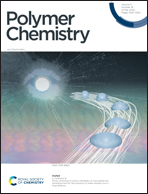Photo-controlled RAFT polymerization mediated by organic/inorganic hybrid photoredox catalysts: enhanced catalytic efficiency†
Abstract
Metalloporphyrins (MTPPs) play an important role in the conversion of light energy to initiate photoinduced electron transfer–reversible addition–fragmentation chain transfer (PET-RAFT) polymerization, in which zinc tetraphenylporphyrin (ZnTPP) has attracted a high degree of attention. However, the self-aggregation effect of porphyrins in some organic solvents such as dimethyl sulphoxide (DMSO) leads to quenching of the excited state of the MTPPs and reduces their photocatalytic capacity in a concentration-dependent manner. In this study, a ZnTPP–POSS organic/inorganic complex was fabricated by linking a polyhedral oligomeric silsesquioxane (POSS) to ZnTPP. The aggregation of the photocatalyst was efficiently depressed in a PET-RAFT polymerization which was catalyzed by ZnTPP–POSS under green light (λmax = 515 nm, 3 mW cm−2). Compared to ZnTPP, the reactions using ZnTPP–POSS as the photocatalyst were well controlled for different monomers with accelerated reaction rates. Well-defined block copolymers were successfully achieved by the chain-extension reaction which demonstrates the high-end fidelities of this polymerization approach.



 Please wait while we load your content...
Please wait while we load your content...